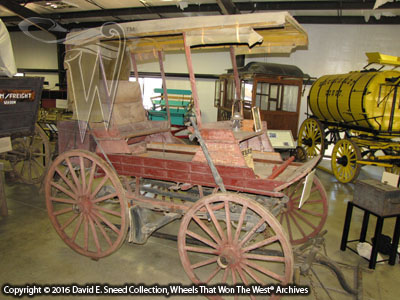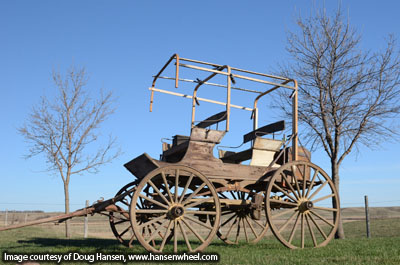When it comes to collecting wagons, I have a penchant for perfection. Tha tdoesn't mean I insist on a flawless character for every vehicle. In fact, as I've written before, some blemishes are actually welcomed as they can help showcase the authenticity and provenance in a set of wheels. In this case, being a perfectionist simply infers that, like most collectors, I have a specific profile I'm looking to fill. Some of those traits were outlined in the "Borrowed Time" book we produced several years ago. In general, we're looking for pieces that best tell the story of America's first and largest transportation industry - especially as each relates to westward travel. It's another reason we continually work to acquire papers from these old makers as well.
One of the most common questions we're asked is, "Where do you find these wagons?" It's an inquiry with both a short and long answer. The short reply is that 'we find them where they are.' I recognize that quip cansound a bit evasive so, today, we'll take the long way around the barn.
"Sometimes you have an instinct, Mae. You see somethin' in a fighter.
You don't even know if it's real, you're lookin' for it so bad."
The quote above is from a scene in "Cinderella Man," a movie based on the Depression-era story of champion heavyweight boxer, James J. Braddock. The Ron Howard film stars Russell Crowe as Braddock, Renee Zellweger as his wife, Mae, and Paul Giamatti as his manager, Joe Gould. In the script above, Gould is trying to convince Mae that James still has a gift when it comes to boxing. He feels that he can see something in Braddock that is exceptionally special.
For serious collectors, I believe there is a connection to this quote. After all, in much the same way, collectors can develop intuitions about certain vehicles. Don't get me wrong... I'm not getting all mystical, talking about some type of clairvoyant message. Rather, I'm referring to experience-based senses that can sometimes cause us to stop and take particular notice of something we might otherwise pass by. In other words, the more time we spend around early vehicles, the easier it becomes to recognize traits that truly stand out from the crowd of survivors. If you've been married for a length of time or are particularly close to someone, you know what I mean. It's possible to become so familiar with another person that we're literally able to finish their sentences. The same thing happens as we spend countless years with these rolling works of wood-wheeled art. After a period of time, it becomes easier to recognize time-honored traits in old friends (brands), that we've spent so much time studying.
Even so, as is the case with any discipline, there's no substitute for sweat equity and time spent in the field. Patience, persistence, and broad experience will drive the process of recognition. Like most other subjects, we can't learn all we need to know from a book. While access to sufficient amounts of old promotional literature is crucial, practical encounters in the field are just as important. We have to spend time in the regions where these old vehicles were used. Not only does that exercise provide valuable knowledge of different environments but it can also expose us to uncommon construction features. Some of those design distinctions may be driven by the demands of the terrain while others can be indicative of a particular brand style.
 |
| This small stage wagon is set on thoroughbraces and includes a rear luggage rack. It's on display in Angels Camp, California. |
So, back to the question... Where do we find the vehicles we've been fortunate to add to our own collection? They've come from almost half of the contiguous U.S. states... North Carolina, Delaware, Pennsylvania, Kentucky, Ohio, Mississippi, Alabama, Arkansas, Missouri, Indiana, Illinois, Iowa, Kansas, Kentucky, Minnesota, North Dakota, South Dakota, California, Nebraska, Texas, Tennessee, Oklahoma, and Colorado. They, literally, are where you find them. The best ones aren't typically sitting along a highway waiting for buyers. Networking, research, and visiting other collections can help you set priorities and goals for your own acquisitions.
One of our newest additions is a small stage wagon from California. This same style of vehicle was referred to as a 'Mail Jerky' by M.P. Henderson in Stockton. These custom vehicles were set up for shorter runs between communities; hauling lighter loads of mail, packages, and passengers. We're pleased to have Doug Hansen and his team of craftsmen helping to conserve this unique set of wheels. The small stage will add an even broader dimension to our collection and studies.

This California stage wagon was built with 1.5" steel axles, triple reach, rear boot, side springs, hand forged foot brake, and heavy brake beam with return spring.
Please Note: As with each of our blog writings, all imagery and text is copyrighted with All Rights Reserved. The material may not be broadcast, published, rewritten, or redistributed without prior written permission from David E. Sneed, Wheels That Won The West® Archives.